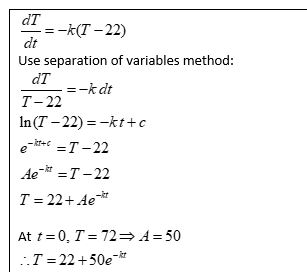Solving the differential equation by separation of variables and sketching the solution curve.
$0.00
Differential equations find a practical application in Newton’s law of cooling, which describes how the temperature of an object changes over time when exposed to a different surrounding temperature. This law can be mathematically modeled using a first-order linear ordinary differential equation, where the rate of change of temperature is proportional to the temperature difference between the object and its surroundings. This equation is typically written as dT/dt = -k(T – Ts), where dT/dt represents the rate of change of temperature, T is the object’s temperature, Ts is the surrounding temperature, and k is the cooling constant. Solving this differential equation helps predict how the object’s temperature evolves over time as it approaches thermal equilibrium with its surroundings.

